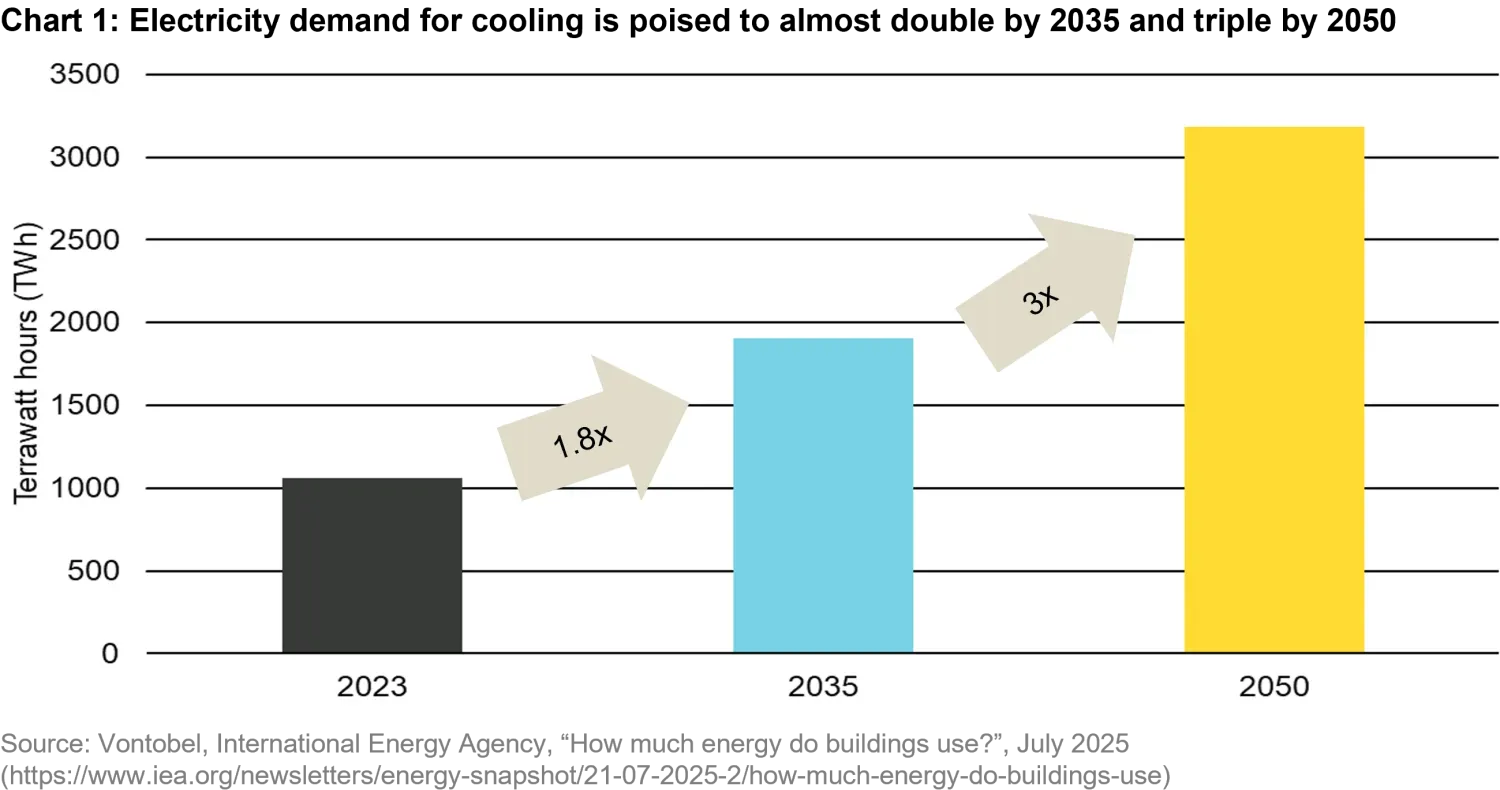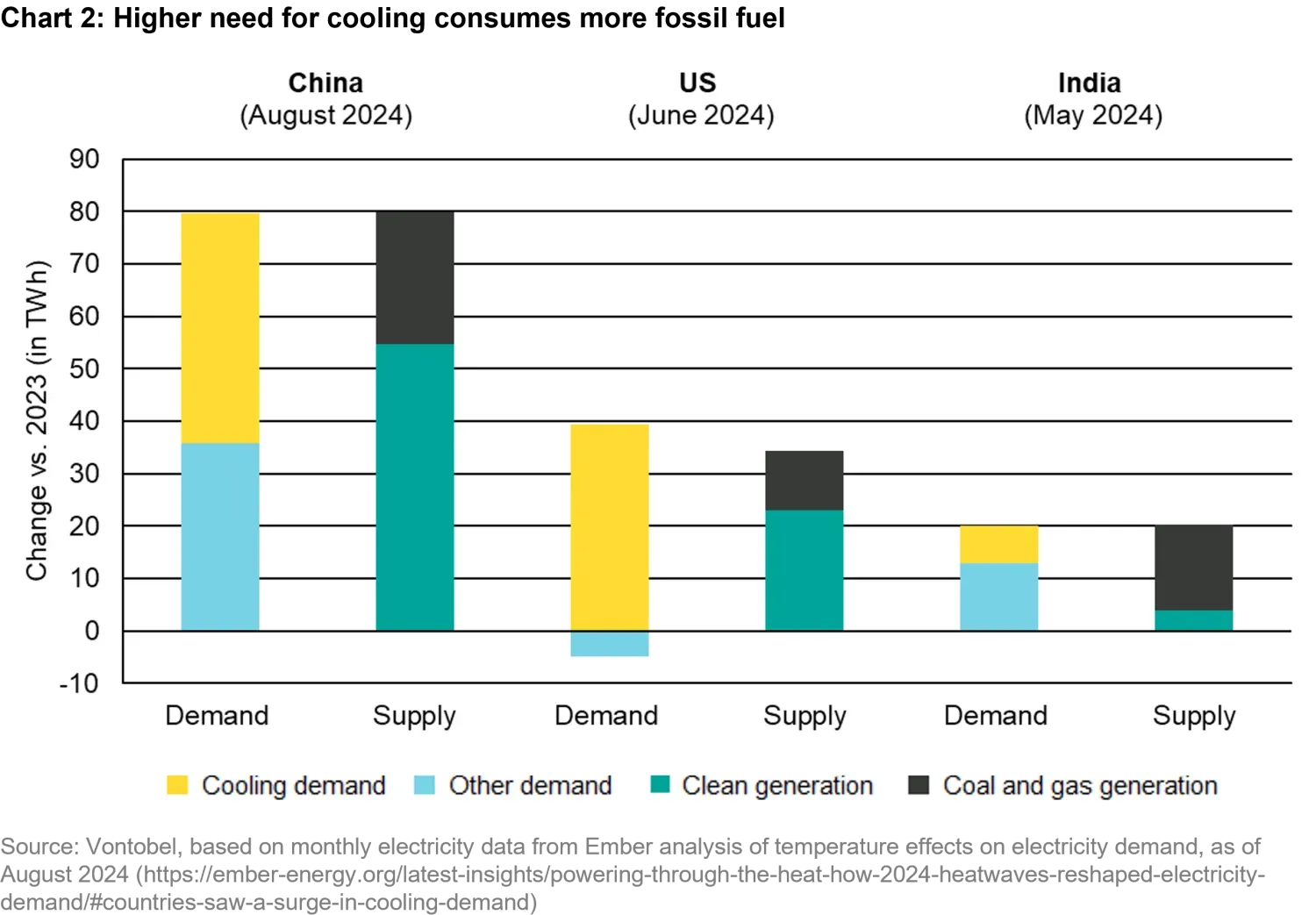Impact Report 2025: Staying the course
In our "Time to adapt?" Viewpoint published earlier this year1, we emphasized the growing importance of adaptation measures in response to the increasing frequency and severity of weather extremes. As our planet faces rising temperatures, many investors are naturally drawn to companies that offer solutions to these challenges. However, we deem it crucial to bear in mind the age-old wisdom: Prevention is better than cure. While adaptation is essential, mitigating climate change and decarbonizing the economy also remain vital for achieving a more sustainable future. To continue our Viewpoint series about how adaptation and mitigation intersect and work together towards a more sustainable world, let’s dive into the world of cooling.
This year, we have experienced another record-breaking hot summer with two significant heatwaves in mid-June and from late June to early July. This once again has demonstrated the unprecedented pace of global warming. With more frequent and intense heatwaves, cooling systems will become a necessity, particularly in the Asian region and other emerging parts of the world, where the effects of climate change are more pronounced compared to the developed parts. It was not much of a surprise when Singapore’s founding prime minister, Lee Kuan Yew, once called air-conditioning “the greatest invention of the 20th century”2. With continued global warming, cooling is expected to become increasingly necessary to protect human health and ensure the resilience of supply chains for food and medicine.
While cooling is essential for adaptation, it comes with a significant challenge: Cooling systems contribute significantly to greenhouse gas emissions, creating a feedback loop that exacerbates global warming. According to the International Energy Agency (IEA), cooling already today accounts for roughly 10 percent of global electricity demand3. This share is expected to rise sharply in the coming years, given the estimated tripling of electricity demand for cooling by 2050.

Moreover, electricity demand for cooling comes with huge spikes during summer. Given sunshine and cooling demand are highly correlated, renewable power can cover part of the additional demand. However, “dirtier” energy sources like coal and natural gas are also needed, creating a vicious cycle of warming and emissions.

The upfront cost of a cooling system adds an additional challenge: In emerging regions, older units – often second-hand, or new but cheaper – with low energy efficiency tend to have high market shares. In such units, hydrofluorocarbon refrigerants often play a greater role, given that in emerging regions, production costs usually are lower and regulatory requirements less stringent than in developed regions. Such refrigerants contain potent greenhouse gases, which are released into the atmosphere throughout the lifecycle of cooling equipment, from manufacturing to disposal. This increases global warming from cooling even further.
We believe that more efficient solutions are essential to address the cooling dilemma. A broad set of promising and scalable mitigation strategies are available that can tackle growing demand for cooling while minimizing its environmental impact. However, it is crucial to take a holistic view with the aim of optimizing the entire system.
It starts outside a building, where further build-out of renewable energy sources combined with additional investments in a smarter and more resilient grid infrastructure can help reduce reliance on fossil fuel during peak times. Inside the building, better insulation helps enable more effective interior temperature regulation, hence reducing the need for additional cooling. Intelligent window blind control and directional ventilation further enhance efficiency.
Another way to address mitigation and manage electricity demand is through demand response and smarter energy use – for example, with cooling systems that can adjust their energy consumption in real time, based on grid demand. This reduces the need for additional power generation during peaks. An essential precondition for effective implementation of such a system is combining smart meters with advanced real-time data analysis.
Crucial for the air-conditioning units themselves are advancements in cooling technology that improve the energy efficiency of the systems – be it inverter air-conditioning units that use variable-speed compressors to dynamically adjust cooling output, or zoned systems that allow for targeted cooling in specific areas, or smart air-conditioning systems that optimize energy use and adapt to real-time conditions.
Another critical step is replacing refrigerants that have high global warming potential by more sustainable alternatives. In this field, the available options include hydrocarbons, such as propane, suitable for smaller air-conditioning units, and ammonia, suitable for large-scale applications.
Below are three examples of suppliers offering solutions to the cooling problems described above:
Saint-Gobain manufactures glass products, high-performance materials, and a broad range of construction materials. Its insulation products for buildings, such as interior and exterior wall insulation materials or double and triple glazed windows, can help reduce the amount of energy needed for heating and cooling.
Carrier offers particularly energy-efficient inverter-type air conditioners (AC), which consume about 30 percent less energy than traditional AC, as they run at sensor-controlled compressor speed. All their appliances use refrigerants with low global warming potential.
Itron designs and services smart meter systems for use primarily in the utility industry, to collect, communicate and analyze power usage data. Smart meters combined with advanced real-time data analysis can help customers reduce their power costs and allow utilities to balance supply and demand during demand peaks.
As the world grapples with rising temperatures, the need for cooling will grow. However, this does not have to come at the expense of our planet. We are convinced that by embracing innovative technologies, improving energy efficiency, and transitioning to much less harmful refrigerants, we can strike a balance between adaptation and mitigation. This way, cooling will not only be a tool for survival but also a step towards a more sustainable world. In addition, this will give both companies and investors the opportunity to benefit from two trends at once: the growing need for cooling and the push for greater energy efficiency.
1 https://am.vontobel.com/en/insights/time-to-adapt, Vontobel, April 2025
2 https://edition.cnn.com/2023/06/09/asia/air-conditioning-singapore-climate-change-intl-hnk-dst, CNN World, June 2023
3 https://www.iea.org/commentaries/keeping-cool-in-a-hotter-world-is-using-more-energy-making-efficiency-more-important-than-ever, IEA, July 2023